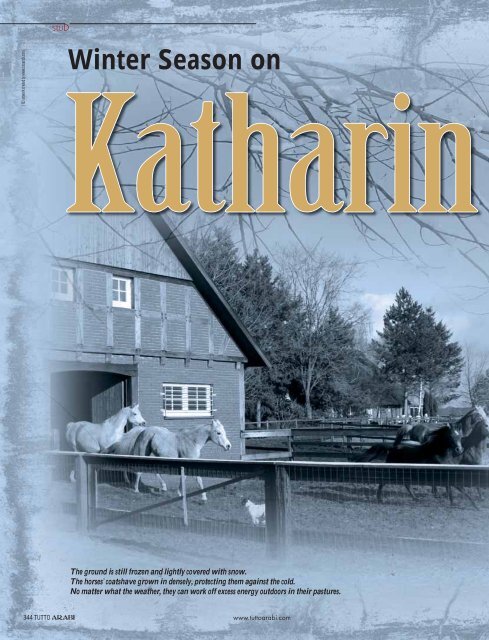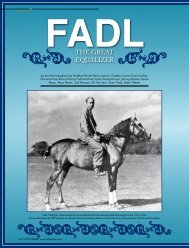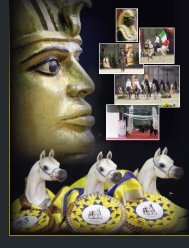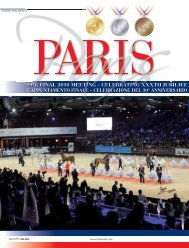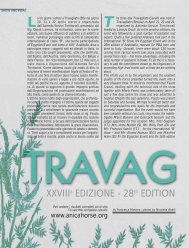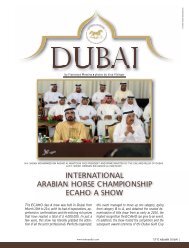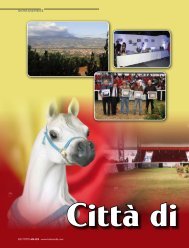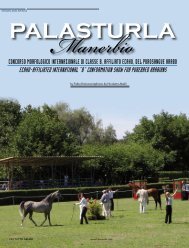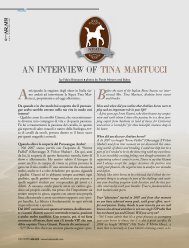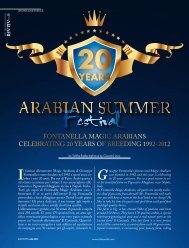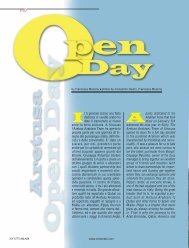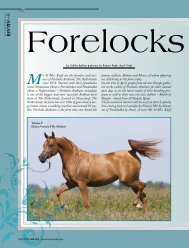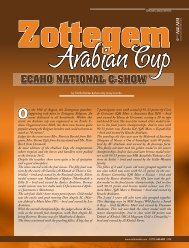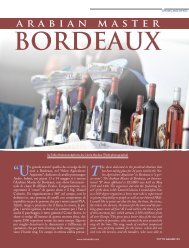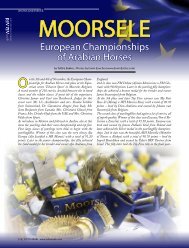Stud - tutto arabi
Stud - tutto arabi
Stud - tutto arabi
Create successful ePaper yourself
Turn your PDF publications into a flip-book with our unique Google optimized e-Paper software.
) © artwork created by www.<strong>tutto</strong><strong>arabi</strong>.com (<br />
STUD<br />
Winter Season on<br />
Katharin<br />
The ground is still frozen and lightly covered with snow.<br />
The horses’ coatshave grown in densely, protecting them against the cold.<br />
No matter what the weather, they can work off excess energy outdoors in their pastures.<br />
344 TUTTO ARABI www.<strong>tutto</strong><strong>arabi</strong>.com
STUD<br />
enhof<br />
Dr. Hans<br />
Nagel<br />
<strong>Stud</strong><br />
by Monika Savier ❚ photos by Monika Savier<br />
The Latest News<br />
from Hans Nagel’s<br />
“Long-Term Experiment<br />
in Arabian Horse Breeding“<br />
Visiting Katharinenhof stud near Bremen in North Germany is<br />
always worth the journey. Dr. Nagel’s horses are in high spirits in<br />
winter, despite their heavy coats, and with the low temperatures,<br />
snow, and rain, they display all of their cheerful temperament and<br />
of their natural beauty. The foal crop of 2010 is weaned, and without<br />
their dams at their sides, it’s even now possible to make out<br />
their respective characters. But what is more: for those who have<br />
followed the “closed breeding concept” of Katharinenhof stud, the<br />
foal crop shows where the stud’s breeding is headed.<br />
www.<strong>tutto</strong><strong>arabi</strong>.com TUTTO ARABI 345
STUD<br />
Quite humbly, when Hans Nagel talks of his<br />
lifetime’s work, he refers to it as a “long-term e<br />
xperiment in Arabian horse breeding”.<br />
But moreover, it’s an artistic synthesis of a whole<br />
range of top-level scientific subjects:<br />
there is genetics in it and reproduction science from<br />
the animal husbandry field, there is historical<br />
research in it and behavioural psychology.<br />
His lifetime’s work is embodied in nine generations<br />
of Straight Egyptian Arabians by now, home-bred<br />
on his Katharinenhof stud near Bremen in North<br />
Germany, and in their famous offspring distributed<br />
all over the five continents of the world.<br />
Until today, they are the gene pool he used<br />
to realise and genetically consolidate his personal<br />
breeding goal. What he aspires to is top-level<br />
quality in the Arabian horses he breeds.<br />
This is why he started out on his very own path<br />
40 years ago -but his eventual destination is not<br />
the journey along this path, but accomplishing<br />
his breeding goal.<br />
“If you have such an idea to breed, it’s very<br />
important to know where you want to go.<br />
If you start from somewhere and you don’t know<br />
where to go, why do you start in the first place?<br />
So you should first think about that. You need<br />
an idea and an objective and this is a very<br />
personal choice. You have to define your<br />
standard. In the course of history, Arabian<br />
horses were used for so many purposes…”<br />
NK ABLA NK ABLA<br />
(NK Jamal El Dine x NK Aziza by NK Hafid Jamil)<br />
Four lovely daughters sired by NK Jamal El Dine<br />
(NK Hafid Jamil x Ansata Ken Ranya by Salaa El Dine)<br />
346 TUTTO ARABI www.<strong>tutto</strong><strong>arabi</strong>.com
Katharinenhof<br />
<strong>Stud</strong><br />
STUD<br />
www.<strong>tutto</strong><strong>arabi</strong>.com TUTTO ARABI 347
STUD<br />
NK NADEER<br />
(NK Hafid Jamil x NK Nadirah by Adnan)<br />
348 TUTTO ARABI www.<strong>tutto</strong><strong>arabi</strong>.com
Katharinenhof<br />
Nagel also represents that utopian dream of finding, ing,<br />
by the slightly ly dished Arabian face; big black eyes; small ears<br />
means of his Arabian horses, a universal language, a with their characteristic shape and position; a proud tail<br />
common idiom shared at least by all those whose lives carriage; and “koheilan”, that black, fully pigmented skin<br />
are touched by horses.<br />
all over.”<br />
Boldly using methodics for his own ends, he developed a<br />
logical framework for successful breeding of his own in the With his strategies and breeding goals, some considered<br />
1970ies, within a few generations creating and genetically<br />
consolidating that very distinctive “Nagel look” in his while others went into opposition to his “long-term expe-<br />
him a role model for Arabian horse breeding world-wide,<br />
Arabian horses. They are easily recognised as products of riment”, more often than not trying to protect their own<br />
his breeding.<br />
markets. But no matter what, during the 1980ies, top<br />
His breeding goal was to maintain the fabled Arabian horses raking the champion titles of World and European<br />
type as found in the horses of the South, the Nejd region. Championships were from Nagel’s breeding. There were<br />
“A chiselled and hardy horse, none too big, a beautiful and the Hanan sons Jamil and Asfour, there were Tiffaha,<br />
well-tempered, typey Arabian horse. Chiselled, hardy, and Narbey, Sherif Pasha, and many others.<br />
none too big - these represent the exotic element, that hint It was in 1967 when he met the filly Hanan on the occasion<br />
of a visit to the Egyptian state stud of El Zahraa.<br />
of the original, barren country of origin of these horses.<br />
Beautiful – that means a harmonious horse, physically He writes: “A spark caught at that moment, a vague idea<br />
well-proportioned and with an elegant lightness throughout.<br />
Well-tempered – that’s the character and the dispo-<br />
my own breeding operation. Who was that filly? How<br />
grew out of nothing into the vision of a horse of my own,<br />
sition to feel attached to people. Typey – that’s displaying might I get her and keep her for good?”<br />
the prominent, unique traits of Arabian horses such as He did get the filly, and Hanan did not only change the<br />
NK KAMAR EL DINE<br />
(NK Hafid Jamil x Ansata Ken Ranya)<br />
<strong>Stud</strong><br />
STUD<br />
www.<strong>tutto</strong><strong>arabi</strong>.com TUTTO ARABI 349
STUD<br />
NK LINA<br />
born in 2010 out of<br />
NK Kamar El Dine x Muneera Al Ariba)<br />
full sister to NK Nasr El Dine<br />
350 TUTTO ARABI www.<strong>tutto</strong><strong>arabi</strong>.com
Katharinenhof<br />
<strong>Stud</strong><br />
STUD<br />
NK NASR EL DINE<br />
(NK kamar El Dine x NK Muneera Al Ariba by Ken Asam)<br />
Nagel world, but with her pedigree, she went on to become<br />
a cornerstone and milestone of many studs all over the<br />
world. The “Hanan Dynasty” (Judith Forbis) was born<br />
and his long-term experiment was ready for takeoff.<br />
Stallions from five Egyptian lines were bred to Hanan<br />
and the other Katharinenhof stock mares, producing five<br />
beautiful daughters and two excellent Hanan sons: Jamil,<br />
and later, Salaa el Dine. They were the foundations of his<br />
breeding.<br />
In a next step, he mated half siblings which were firstgeneration<br />
descendants of Hanan. However, he was still<br />
on the lookout for improving his breeding. „Later on I un-<br />
derstood that a horse needs to have, among others, a good<br />
shoulder, a good croup, and certainly the type. By the time<br />
we were all learning and I was looking around for where<br />
to find a horse with type, a good shoulder, and a good<br />
croup. Finally I found this horse, he was Ansata Halim<br />
Shah and I was imagining that Halim Shah might be the<br />
horse I was searching for.”<br />
In a trans-atlantic exchange, Jamil went to the US to<br />
take up residence with Judith Forbis, while Ansata Halim<br />
Shah stayed in Katharinenhof stud for two years as a sire.<br />
This joint strategy of two great Arabian breeders from<br />
two continents proved to be a stroke of luck for future<br />
www.<strong>tutto</strong><strong>arabi</strong>.com TUTTO ARABI 351
STUD<br />
NK NOUR<br />
(NK Hafid Jamil x NK Noha by NK Jamal El Dine)<br />
NK NABAWIA<br />
(NK Nadeer x NK Nabeelah by<br />
NK Nahaman)<br />
breeding all over the world.<br />
“Jamilll (Madkour I x Hanan), 1975-1986, known for<br />
his big black eyes, short sharp ears, long neck and overall<br />
harmony. He blended beautifully with the linebred<br />
Ansata stock creating a new era in the Ansata program”.<br />
(Judith Forbis)<br />
Until today, there is no mistaking that positive influence<br />
Jamil had in Arabian breeding. Big round black ears, a<br />
great presence, combined with a playful self-assurance –<br />
all of these served to make him an iconic stallion even up<br />
to today.<br />
When Jamil came back from the US, he served another<br />
6 mares in his Katharinenhof home before dying from<br />
causes still unknown. Nagel was not to be discouraged,<br />
however.<br />
“I had lost my stallion Jamil and I was desperately<br />
searching for an alternative when my mare Hanan, sired<br />
by Ansata Halim Shah, produced me the little Salaa El<br />
Dine. Later on, Salaa El Dine became a stallion that<br />
produced d both, mares and stallions, in very good quality,<br />
just like his father Halim Shah had done. Salaa El Dine<br />
influenced my breeding to a much greater extent than all<br />
the other stallions have ever done. The one son I particularly<br />
liked was ADNAN. Adnan was somewhat of a copy<br />
of old Ghazal but with the advantage of having a good<br />
back.”<br />
Towards the end of that second series of experiments, there<br />
were 13 offspring to be counted, all of them tailing back to<br />
Hanan maternally or paternally, and all of them being,<br />
as Nagel writes, typey and chiselled Arabians, without<br />
even a single undesirable exception.<br />
He had set a breeding goal for himself, and he never lost<br />
it out of sight. In the course of several more generations,<br />
Nagel created a closed stock population with their positive<br />
traits, phenotype as well as genotype, firmly consolidated<br />
by their close and repeated pedigree relations.<br />
“Mares are for maintaining a breed, stallions are for<br />
improving it“. If I keep to this saying, then any stallion<br />
352 TUTTO ARABI www.<strong>tutto</strong><strong>arabi</strong>.com
Katharinenhof<br />
<strong>Stud</strong><br />
STUD<br />
NK NERHAM<br />
NK NERHAM<br />
was born in 2008,<br />
her sire is NK Jamal El Dine<br />
and her dam is<br />
NK Nabeelah by Nahaman<br />
NK NEFISA<br />
(NK Nadeer x NK Aziza by<br />
NK Hafid Jamil)<br />
www.<strong>tutto</strong><strong>arabi</strong>.com TUTTO ARABI 353
STUD<br />
I ever use needs to have some excellent trait which will<br />
improve my breeding. It’s not always possible to know<br />
that, sometimes you just have to give it a try”.<br />
He went on experimenting, without introducing fresh<br />
blood. There were his stallions<br />
Salaa el Dine (Ansata Halim Shah x Hanan)<br />
Nejdy (Salaa el Dine x Lotfeia)<br />
Ibn Nejdy (Nejdy x Gazalla)<br />
who put their respective stamps on his breeding goal for<br />
years. The most prominent inheritor among them was<br />
Salaa el Dine, producing the most beautiful offspring<br />
particularly out of Jamil mares. Sadly, his son Nejdy died<br />
early, but he left his son Ibn Nejdy in his tracks, who in his<br />
turn will be unforgettable as the sire of NK Hafid Jamil<br />
(Ibn Nejdy x Helala).<br />
Says Nagel: When considering his dam, bay Helala of the<br />
Bukra line, as well as the features of his sire, it is very hard<br />
to find out where NK Hafid Jamil received his features<br />
from. He looks different from both of them, simply a new<br />
Arabian type. He is presenting himself as a proud horse,<br />
his head in fact unique in Egyptian breeding: small, broad<br />
in the forehead, a very fine muzzle with huge nostrils,<br />
black eyes, small ears, connected to a very well- formed<br />
neck. He has an excellent shoulder, is broad in the chest,<br />
but weak in his top line. In total: a horse which has a<br />
perfect front part, but is faulty in his hind section, with<br />
a relatively short croup and straight hind legs. Again,<br />
inherited from the Hadbans. Certain important breeders<br />
would never have used this horse. However, he was offered<br />
his chance with high-quality mares with good strong hindquarters.<br />
It was definitely tempting to use this horse for<br />
his magnificent head and his neck/shoulder-formation.”<br />
But NK Hafid Jamil, presently serving as a sire in<br />
Saudi Arabia, is not the only sire represented by brilliant<br />
offspring on Katharinenhof stud. There are his prominent<br />
sons<br />
NK Jamal el Dine (NK Hafid Jamil x Ansata Ken Ranya)<br />
NK Kamar el Dine (NK Hafid Jamil x Ansata Ken<br />
Ranya)<br />
NK Nadeer (NK Hafid Jamil x Nadirah)<br />
who are the leading sires there today, proudly presenting<br />
their enormously typey offspring. With regard to NK<br />
Nadeer, Nagel writes:<br />
“NK Nadeer was a gift for the stud and in many respects<br />
a copy of his sire. To be sure, he is correctly built and fully<br />
harmonious, a horse completely rounded in front and<br />
back. It was not difficult to decide that NK Nadeer would<br />
stay at Katharinenhof as one of the most suitable followers<br />
of Salaa el Dine. Apparently due to his dam and<br />
his grandfather Adnan, he was able to overcome his sire’s<br />
conformation shortcomings, at the same time maintaining<br />
all the other positive elements, mainly the unique type<br />
presented by these horses. He has the typical Hadban look,<br />
a square horse, long on his legs, a wonderful tail carriage,<br />
and his type an attraction in itself.”<br />
Regarding NK Jamal el Dine – who is very well ridden<br />
on top of everything else - and NK Kamar el Dine, Nagel<br />
writes:<br />
“The two full brothers, Jamal el Dine and Kamar el Dine,<br />
are of two different types. They will both be kept in the<br />
stud for further breeding.”<br />
“Jamal el Dine greatly resembles his ancestor Jamil. He is<br />
a tall horse, his conformation is acceptable, he even has a<br />
high croup and his hind legs are a legacy of his sire. However,<br />
his neck is of a brilliant shape and well attached to<br />
head and shoulder. A feature which ought to be even more<br />
widely consolidated in the herd, since it is one of the weak<br />
elements in many Egyptian horses as previously mentioned.”<br />
“Kamar el Dine has a wonderful bay colour. He is an<br />
elegant horse, a little bit long in the back, but with a<br />
good croup, a perfect mover, with a wonderful masculine<br />
expression. With him, finally a stallion was born with a<br />
highly appreciated colour, which is useful to make sure that<br />
pigmentation problems will not arise or could be handled<br />
immediately with proper breeding.”<br />
The offspring of these sires is much in demand and not<br />
readily for sale, as the long-term experiment on Katharinenhof<br />
is the overriding consideration. However, a visit to<br />
the stud, meeting and assessing Nagel’s long-term experiment<br />
personally, is worth every breeders’ time.<br />
Again and again and ever patient, he encourages the<br />
countless visitors from Europe, from the Middle East, the<br />
US, and Australia. He encourages them to breed, to maintain<br />
this precious breed of horses. He tries to interest them,<br />
to motivate them, to encourage them to define a breeding<br />
goal of their own. He is a role model for small breeders: his<br />
stock was deliberately designed not as a numerous population<br />
offering a playing ground for grand experiments,<br />
but as a small herd on a private stud, based on a concept<br />
of quality, not of numbers, and managed with a wellgrounded<br />
expertise in genetics. This made for successful<br />
implementation of his concept. A concept serving as a<br />
fascinating model for most private breeders, as the lessons<br />
of experience collected here are most probably conferrable<br />
and practicable to small studs everywhere. ❑<br />
354 TUTTO ARABI www.<strong>tutto</strong><strong>arabi</strong>.com
Katharinenhof<br />
<strong>Stud</strong><br />
STUD<br />
NK HAFID JAMIL<br />
(Ibn Nejdy x Helala)<br />
NK Hafid Jamil is the leading sire of Katharinenhof stud. The picture shows<br />
him in summer 2010. This excelling 15-year-old Dahman Shawan stallion is<br />
presently leased to Saudi Arabia as a sire. His sons, NK Kamar El Dine, NK<br />
Jamal El Dine, and NK Nadeer, have taken over his job at his home stud for<br />
this season.<br />
www.<strong>tutto</strong><strong>arabi</strong>.com TUTTO ARABI 355


